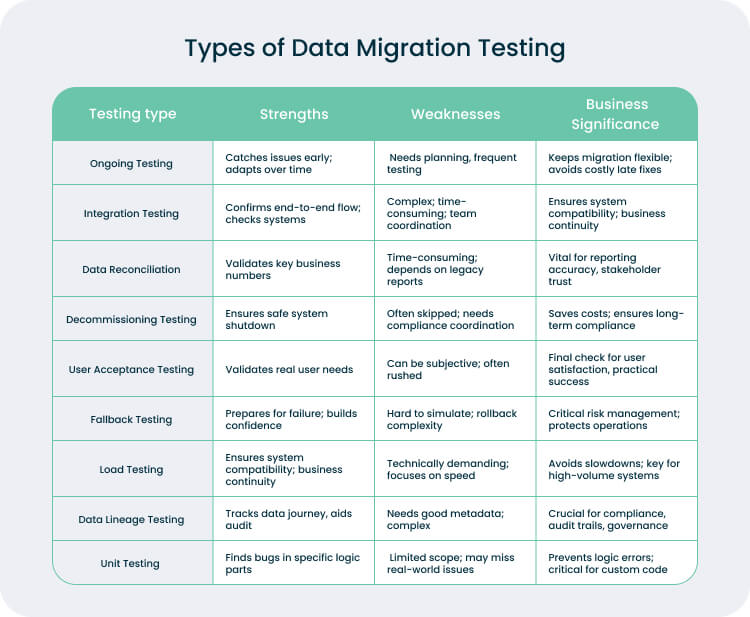Have you ever tried moving to a new apartment and realized that your couch doesn’t fit the new place, and some of your boxes are missing? That’s how the data migration process can feel without a strategic plan.
According to Gartner, 83% of data migration projects either fail or go over time and budget. And Forbes adds more fuel to the fire: 82% of businesses experience at least one unplanned downtime during the migration process. As a result, they deal with lower productivity, delayed revenue, and stressed teams.
The problem isn’t just moving data but ensuring your data integrity and data quality. Forbes warns that poor-quality data costs companies nearly $13 million every year. If you don’t clean or test it, you face issues such as duplicate records, mismatched fields, and systems that don’t work well together. That so-called “simple migration” quickly becomes a big headache.
But we also have some good news for you. Companies that test their data during migration have 50% fewer errors and 40% faster deployment, according to Forrester. In other words, a data migration testing strategy is the secret weapon that saves you time, ensures data integrity, and cuts costs.
But what are the types of data transformation testing? Why does it matter for your business? And how can you do it efficiently? We’ll cover all these points and more in this article. Keep reading.
What’s Behind Data Migration Testing?
If you decide to upgrade your target system, move to the cloud, or replace old software, one thing always needs to happen: the data transfer process. It means you have to migrate all your valuable data to a new system. Sounds simple, right?
But it’s not as easy as it seems. First, make sure you’re doing it safely. Second, you shouldn’t lose important datasets. With data transfer testing, you can be confident that your data moves safely from system A to system B without missing information, broken links, or strange formatting, all while preserving data integrity.
Data migration tools check your data before, during, and after movement. As a result, everything still works, and nothing breaks your business in the process.
So if you’re planning a big system shift, don’t skip this step. It can mean the difference between a smooth move and a data disaster.
Why Data Migration Testing Is Important: Benefits You Can’t Ignore
Thinking of data migration as a safe process? We have to warn you: every time you move data or systems from one platform to another, you’re taking a risk. Without proper migration testing, that risk can lead to lost data, broken features, frustrated users, or worse, a complete system crash.
But we’re not here to scare you. We want to make sure you don’t skip this critical step: data transfer testing. It’s essential to ensure a smooth and successful data migration and protect everything you’ve built.
Clean and accurate data
Nobody wants data loss, duplicate records, or corrupted files. Testing helps make sure migrated data is copied over just right, without surprises. As a result, data transformation testing keeps your data clean and accurate.
Data validation and testing strategies also matter if you want to operate within your budget and timeframes and ensure project success.
High system performance
The last thing you want during a data migration process is for your systems to go down. Testing catches problems early, so your team (and your customers) don’t feel the pain. So, with quality data transfer testing, you shouldn’t worry about performance drops.
Thanks to the early detection of schema drift, encoding mismatches, and data loss, you will experience fewer post-migration issues and faster deployment times.
Compliance with laws and regulations
In 2025, GDPR fines hit a record high, with some penalties reaching €1.2 billion due to improper data transfers and missed user consent, according to Statista.
If your migration process involves sensitive data, there’s no room for error. Data transformation testing helps ensure you handle personal data correctly, keeping you compliant with strict regulations like GDPR and HIPAA, and protecting your business from costly legal trouble.
Fast and functional system
Just because your migrated data made it over doesn’t mean everything runs smoothly. Performance testing ensures your new system works as expected. So, it will be fast, stable, and reliable.
When combined with data transfer testing, performance testing confirms that the new environment can handle the expected workload. This helps maintain business continuity and keeps users happy after your actual migration.
All in all, a data migration testing strategy isn’t just nice to have after the transfer. It’s a crucial step that saves time and money, prevents unpleasant surprises, and keeps your users happy.
Need help with testing? The Forbytes team is here for you. We know how to handle migrations smoothly and efficiently, without any performance drops.
Types of Data Migration Testing: Weaknesses, Strengths & Why They Matter
Moving your data from one system to another might seem like a simple copy-and-paste job. But in reality, it’s a risky process that can impact your entire business. If something goes wrong during the migration process, the consequences can be disastrous, especially if data mapping isn’t done correctly.
Every company approaches migration testing differently. That’s why each type of testing has its strengths and weaknesses. It’s important to understand what each test brings to the table and what its limitations are.
Ongoing testing
Strengths: This type of migration testing finds problems early before they get big. It works well as your project changes. Ongoing testing supports automation and quick feedback and fits nicely into agile work.
Weaknesses: You need a good migration testing setup and people to do it often. If you only test with small data, you might miss critical issues or fall into the trap of poor data analysis, which can lead to incorrect assumptions and flawed decisions.
Why it matters: Ongoing testing helps you stay flexible and catch issues before they grow. It saves you from big surprises and costs later, especially in long projects.
Unit testing
Strengths: Unit testing finds bugs in small parts of your data migration. It’s good for checking tricky data changes or business rules. It works well with visual tools and modular designs.
Weaknesses: Unit testing only checks pieces, not the whole flow. But you need clear documents and details. Plus, this test might miss real problems that users face.
Why it matters: Unit testing helps prevent logical mistakes that can result in bad reports, poor data quality, or compliance issues. Additionally, this test works when it comes to custom code or complex data changes, especially when powered by the right automated testing tool.
Integration testing
Strengths: Integration testing checks whether all systems and tools work well together. It runs the full migration flow and makes sure everything works smoothly.
Weaknesses: This type of migration testing can be hard to set up and takes more time. It needs teams to work together, which can slow things down.
Why it matters: Integration testing helps you avoid problems with systems not working together. It ensures that your whole data flow, starting from source data, works correctly, so your business runs without performance drops or surprises after deployment.
Load testing
Strengths: Load testing shows how your target system performs when handling large volumes of migrated data. It helps identify performance bottlenecks, slow response times, and system limitations. This kind of data migration testing is great for planning capacity and improving speed.
Weaknesses: It can be tricky to simulate real-world traffic and data loads. You may need extra servers or dedicated test environments. While load testing measures speed and performance, it doesn’t always verify data accuracy.
Why it matters: Load testing is essential if your business deals with high data volumes or needs fast, responsive systems. It helps prevent slowdowns that could affect user experience, business operations, or revenue.
Fallback testing
Strengths: Fallback testing lowers the risk of downtime if a target system crashes. This type of data migration testing gives you a safety net and builds trust.
Weaknesses: It’s difficult to test failures in a real way. Rollbacks can be tricky and costly. Many teams don’t test this enough.
Why it matters: Fallback testing is vital for managing risk. It protects your business if things fail, particularly when it comes to finance, healthcare, and e-commerce.
Decommissioning testing
Strengths: Decommissioning testing makes sure you shut down legacy systems safely. It checks that old data is still easy to find. This type of data migration helps you find hidden links or reports you might miss.
Weaknesses: Teams often skip this testing to move faster. Plus, they might need help from compliance teams.
Why it matters: Decommissioning testing saves money by turning off old systems. It keeps you compliant and makes sure you can still access old data. This is very important in regulated industries.
Data reconciliation (data audit)
Strengths: Data audit checks whether important numbers match before and after data migration. It builds trust with stakeholders and proves real business value, not just a tech move.
Weaknesses: Small format or rounding issues can cause false problems. It can be manual and time-consuming.
Why it matters: This type of data migration testing is critical for areas like finance, sales, and executive reporting. If the numbers don’t coincide, it can damage trust in the entire migration, and in your data integrity and accuracy overall.
Data lineage testing
Strengths: Data lineage testing tracks each step of the data movement. It helps you find where problems or changes come from and is good for impact checks and audits.
Weaknesses: This type of testing requires thorough documentation and well-maintained metadata. In complex environments with multiple data sources, it can be difficult to practice this type of testing.
Why it matters: Data lineage testing is critical for keeping data transparency. It is especially important in finance, healthcare, and other regulated industries where compliance is a must. As a result, teams can confidently answer questions like, “Where did this number come from?” and ensure that data integrity is preserved.
User acceptance testing (UAT)
Strengths: UAT checks that the new system works for real users. It finds problems with how people use the system that tech teams might miss. User acceptance testing builds trust with everyone involved.
Weaknesses: This type of data migration testing can be personal and different for each user. Teams often rush or skip it when time is short.
Why it matters: UAT is the last check. It ensures that your data transfer process works not just in theory, but for the people who use it every day.
Each type of migration testing has its job. Some find bugs early. Some check speed and performance. Others make sure users are happy or that the data is safe. You need them all to ensure quality data, as well as data integrity.
Skipping testing is a risk. Guessing is a risk. Good testing isn’t just a smart move; it’s how you protect your business and keep things running. It gives you peace of mind and lets you move forward with confidence.
Main Steps in Data Migration Testing: Quick Guide
Data migration testing is key to a smooth and secure migration. But it’s important to follow all the main stages: pre-migration testing, migration testing, and post-migration testing. Sticking to these steps helps you stay on track and keeps your business running without unnecessary risks.
Stage 1. Pre-migration testing: plan, prepare, simulate
Before moving any data, create a clear plan for data migration testing: know what data you’re transferring, why, when, and who’s involved. Choose the right data testing tools and environments for trial runs. Analyze your source data, where it is, and its conditions.
Always back up your data safely before starting. Map your migrated data carefully so legacy and new systems match in names, formats, and required values. Run early test cases on small samples to check if the data fits the new system’s rules. Skipping pre migration testing is like flying without checking your fuel.
Stage 2. Migration testing: monitor in real-time
Now it’s showtime, but testing doesn’t stop here. Monitor your migrated data as it moves, and look out for errors or slowdowns. Keep validating in real-time by comparing the data that’s moved to what you expect, checking for anything missing or changed.
Also, test how the new system works with your other tools to make sure they still connect smoothly. Get real users involved to review the data and reveal whether it makes sense to them. Can they do their work without problems? This real-time data migration testing helps you catch and fix issues during the migration process before they cause bigger damage.
Stage 3. Post-migration testing: double-check everything
You’re not done yet. Now it’s time to check everything one last time. Make sure your data grows, and reports are correct. See if people can easily find and use the data. Also, check if the new system is fast enough for daily work and busy times.
Don’t forget to update your documents with all the steps, settings, and backup plans. Post migration testing shows that your transfer process works well and makes your new system more reliable. It’s the final check before moving forward.
Data migration isn’t just a tech task; it’s a crucial part of your business. One tiny mistake can cause big problems for teams, customers, and finances. Data migration testing gives you control. It changes a risky move into a smooth and safe transferring process.
So, if you’re getting ready for a major system update, don’t just cross your fingers and hope for the best. Get it done right with smart testing.
Forbytes can help you plan and run thorough data migration testing to keep your business safe and running strong. Reach out to us today!
Top Challenges in Data Migration Testing and How to Overcome Them
Why hide the truth? Data migration testing is a challenging process. But when you know what issues to expect and prepare for them, they become much easier to handle. That’s why we’ve put together this list, not just of common challenges, but how you can overcome them:
Poor data quality → Quality checks
Moving data sounds simple until you start doing this. You might think your migrated data is clean, but then you find missing fields or duplicate records. If the data is messy before, it will stay messy after. And that could cause problems with your new system.
The solution is to clean things up early. Run data checks before you move anything. Fix errors, remove duplicates, and make sure everything is in the right format. Use data migration testing tools that help you fix problems automatically.
Data mismatch → Data mapping
Sometimes after the migration process, the data looks wrong. Maybe the date format changed, or the currency fields didn’t transfer correctly. Even small data transformations like these can mess up reports or cause other performance drops.
The solution is to plan your data mapping carefully. Make sure each field in the target system matches the right one in the new system. Use rules to keep formats consistent. Run test loads and compare sample data between the old and new systems. This helps you catch problems early before they cause bigger problems.
Data loss → Backup strategy
Sometimes, not all data can be moved to the new system. You might lose data because of failed transfers, broken processes, or missing backups. This can cause big problems, especially if the lost data is sensitive or needed for legal reasons.
To avoid this, always create a backup before you start. Use audit logs and reports to track what moved and what didn’t. During and after the data transferring process, check row counts, totals, and sample records to make sure nothing is missing.
Large volumes of data → Automation tools
Moving a huge amount of data can take too long, sometimes longer than you planned. It can slow things down and delay data migration testing.
To fix this, use automation tools to speed up loading and testing. Break the migration into smaller parts to manage it better. And test system performance ahead of time so you can adjust your scripts and avoid slowdowns during the real move.
Data transferring testing touches every part of your business, not just your systems, but your daily work, reports, and decisions. The good news? These challenges can be solved. With careful planning, the right tests, and smart use of tools, you can avoid costly mistakes and make your migration smooth and safe.
Need assistance with choosing the right tools? Forbytes is here to help. We’ll guide you through the process and make sure your data migration stays on track.
Data Migration Testing Best Practices: Expert Tips for Success
If you’ve ever moved to a new apartment, you need not only to pack boxes but also make
sure everything arrives safely, works in the new place, and nothing gets lost along the way.
Migrating your data is something like this but on a much bigger scale. And without a detailed data transfer testing plan, things can get difficult very fast.
The good news? With a few smart moves, you can avoid chaos. Here are 5 simple best practices to help your data migration go off without mess:
- Start with a solid plan: Before anything happens, get everyone on the same page with a clear, detailed data migration plan. It should outline what data is moving, how testing will be done, and who’s responsible, and include risks, budget, and backup plans.
- Take care of security: Protect sensitive migrated data. Use masking or tokenization, tighten access controls, and follow privacy laws like GDPR or HIPAA.
- Test gradually: Start with a test run on sample migrated data. Catch what breaks, fix it, and scale up only when you’re confident it works.
- Back up your data: Back up your source data before you start anything. If something goes wrong, you need a way to roll back without losing valuable information.
- Build your expert team: Don’t do this alone; build a dedicated migration testing team that understands your data, systems, and goals. They’ll design tests, monitor each phase, and quickly tackle issues as they arise.
With these simple steps, data transformation testing doesn’t have to be stressful. When you prepare well, test smart, and have a team that knows your data, the process goes smoothly and works every time. Spending time on this now saves problems later and keeps your business running.
Next Steps: How to Start or Improve Your Data Migration Testing Process
Whether you’re preparing for a full system upgrade or just want to avoid future data issues, now is the perfect time to start your data transfer testing plan. Begin small, align your team, and include testing at every stage of the process.
If you’re already migrating, add iterative testing and quality checks; if you’re planning ahead, map your data, define test cases, and secure your rollback strategy.
Not sure where to start? Forbytes provides expert data engineering services to guide you through a smooth, secure, and stress-free migration.
Talk to our team today to build a data migration testing approach tailored to your business.

Our Engineers
Can Help
Are you ready to discover all benefits of running a business in the digital era?

Our Engineers
Can Help
Are you ready to discover all benefits of running a business in the digital era?












